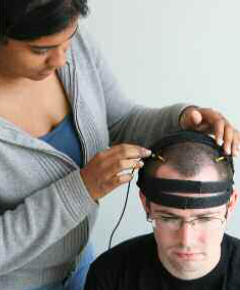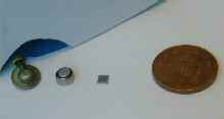By Alexander J. Casson
The increasing global population and increasing average age in many countries is driving a change towards providing personalized healthcare. In turn, this change is driving the development of highly miniaturized, wearable sensors that can be placed on the body to monitor a variety of vital signs. For example, it is common for even amateur runners to wear a heart rate (electrocardiogram, ECG) monitor while training. These devices allow the runner to better focus their training for improvement, and moreover, allow them to monitor their own heart and health so that they can focus on living a healthy lifestyle. In terms of providing personalized healthcare, there is even a heart rate monitor extension available for the Texas Instruments eZ430- Chronos programmable watch. This is a wireless development platform incorporating Texas Instruments’ low power microcontroller and transceiver components, and keen users can use this to design, program and customize their own personal heart rate systems.
The electroencephalogram, or EEG, is in principle exactly the same as the ECG but with electrodes placed on the head to record the electrical signals that arise from the brain rather than the ones which arise from the heart and are recorded from the chest. In practice, however, the EEG is much more difficult to record than the ECG. This is due to a variety of reasons – EEG signals are much smaller than ECG signals and as a result, more sensitive and noise-free equipment is required; more electrodes are usually required; there is generally more hair on the head than on the chest making the electrodes more difficult to connect correctly; and moreover, the head is less physically and visually accessible than the chest, and so a single person cannot easily set up a system on themselves (see Fig. 1). Whilst some of these are fundamental restrictions, huge progress towards realizing personalized EEG systems has nevertheless been made in recent years. The emotiv EPOC and Camntech Actiwave are two examples of commercially available highly miniaturized units, and there are many more examples too numerous to discuss here.

Figure 1: Setup of a standard EEG recording. The EEG is generally much more difficult to record than the ECG and hence future systems require innovations on a number of fronts. For example, as the head is not visible and electrodes must make contact with the scalp through the hair a trained second person is required to setup the system. Photo: Neville Miles.
In addition, research institutes around the world are tackling the issues highlighted above to create truly wearable EEG systems. These will require mitigating, or devising techniques to tolerate, the electrode attachment issues. The total system power consumption must also be reduced. For user acceptability decreased power consumption means that battery changing and charging can become a thing of the past, making the devices easier to use. They just turn on and work. For social acceptability, decreased power consumption means that the EEG unit can be smaller, more discrete and more easily tolerated (see Fig. 2). To create these highly miniaturized systems the problems highlighted above must be overcome, requiring innovations at the system design, electronic design and mechanical design levels. However, to realize truly wearable systems, innovations at the medical, application and personalization levels are also essential.

Figure 2: The scale required for future truly wearable EEG systems: a standard recording electrode, a large coin cell battery, unpackaged electronics and a British one pence piece for scale. Ideally the recording electrode would be the single largest component present. Photo: Eduardo Aguilar-Pelaez.
In many medical applications which use the EEG at present, such as epilepsy diagnosis and sleep disorder diagnosis, diagnostic patterns in the EEG are identified by eye by a highly trained physician. This isn’t practical for future wearable systems where ever longer recordings are generated from a larger number of users. Instead, automated, realtime, signal analysis is mandatory, although this introduces new challenges and necessitates application-personalization in the design of future EEG systems.
As an example, research into automated seizure detection algorithms has been going on for more than forty years. Unfortunately, despite the huge increases in computational power available during that time, a definitive, clinically accepted procedure has yet to emerge. No algorithm has perfect accuracy. The key challenge in creating truly wearable systems is not just in implementing seizure detection algorithms in very low power consumption circuits to stay within the limits highlighted above, but also in devising applications and situations where the performance of the EEG system is robust and reliable, despite the fact that no algorithm is perfect.
Expanding on the seizure detection example, false detections inevitably mean that automated algorithms integrated into miniaturized EEG systems cannot be used to produce a fully accurate and reliable diary of seizure activity. This does not mean that such systems are of no benefit, just that a different application must be pursued. The detection algorithm could be used to highlight sections of data that are of potential interest, decreasing the analysis time for a trained physician even when some false detections are present; or algorithms can be used to decrease the average power consumption of the EEG system by turning parts of the system off when no interesting activity is present. The longer monitoring enabled could potentially detect previously unknown phenomena which would impact both diagnosis and treatment decisions.
Thus, realizing truly wearable EEG systems also relies on realizing personalized EEG systems, tailored for the particular medical situation at hand. For ECG monitoring user personalization is already becoming available. The EEG equivalent is inevitably more difficult, but at Imperial College in London we are continuing the required research into system, algorithm, and circuit design. The aim is to create application-personalized wearable systems that utilize the medical application to ensure that robust and useful performance is maintained, despite the fact that the algorithm performance cannot be perfect. In addition to addressing the electronic and mechanical issues, this focus on the application aim and application- personalization is essential as we move from highly miniaturized to truly wearable devices.
Alexander Casson, Ph. D. Imperial College London U.K. acasson@imperial.ac.uk
About Brenda Wiederhold
President of Virtual Reality Medical Institute (VRMI) in Brussels, Belgium.
Executive VP Virtual Reality Medical Center (VRMC), based in San Diego and Los Angeles, California.
CEO of Interactive Media Institute a 501c3 non-profit
Clinical Instructor in Department of Psychiatry at UCSD
Founder of CyberPsychology, CyberTherapy, & Social Networking Conference
Visiting Professor at Catholic University Milan.








